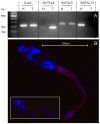The Schistosoma mansoni tegumental-allergen-like (TAL) protein family: influence of developmental expression on human IgE responses
- PMID: 22509417
- PMCID: PMC3317908
- DOI: 10.1371/journal.pntd.0001593
The Schistosoma mansoni tegumental-allergen-like (TAL) protein family: influence of developmental expression on human IgE responses
Abstract
Background: A human IgE response to Sm22.6 (a dominant IgE target in Schistosoma mansoni) is associated with the development of partial immunity. Located inside the tegument, the molecule belongs to a family of proteins from parasitic platyhelminths, the Tegument-Allergen-Like proteins (TALs). In addition to containing dynein-light-chain domains, these TALs also contain EF-hand domains similar to those found in numerous EF-hand allergens.
Methodology/principal findings: S. mansoni genome searches revealed 13 members (SmTAL1-13) within the species. Recent microarray data demonstrated they have a wide range of life-cycle transcriptional profiles. We expressed SmTAL1 (Sm22.6), SmTAL2, 3, 4, 5 and 13 as recombinant proteins and measured IgE and IgG4 in 200 infected males (7-60 years) from a schistosomiasis endemic region in Uganda. For SmTAL1 and 3 (transcribed in schistosomula through adult-worms and adult-worms, respectively) and SmTAL5 (transcribed in cercariae through adult-worms), detectable IgE responses were rare in 7-9 year olds, but increased with age. At all ages, IgE to SmTAL2 (expressed constitutively), was rare while anti-SmTAL2 IgG4 was common. Levels of IgE and IgG4 to SmTAL4 and 13 (transcribed predominantly in the cercariae/skin stage) were all low.
Conclusions: We have not measured SmTAL protein abundance or exposure in live parasites, but the antibody data suggests to us that, in endemic areas, there is priming and boosting of IgE to adult-worm SmTALs by occasional death of long-lived worms, desensitization to egg SmTALs through continuous exposure to dying eggs and low immunogenicity of larval SmTALs due to immunosuppression in the skin by the parasite. Of these, it is the gradual increase in IgE to the worm antigens that parallels age-dependent immunity seen in endemic areas.
Conflict of interest statement
The authors have declared that no competing interests exist.
Figures






Similar articles
-
Factors affecting human IgE and IgG responses to allergen-like Schistosoma mansoni antigens: Molecular structure and patterns of in vivo exposure.Int Arch Allergy Immunol. 2007;142(1):40-50. doi: 10.1159/000095997. Epub 2006 Oct 2. Int Arch Allergy Immunol. 2007. PMID: 17019080
-
Progressive cross-reactivity in IgE responses: an explanation for the slow development of human immunity to schistosomiasis?Infect Immun. 2012 Dec;80(12):4264-70. doi: 10.1128/IAI.00641-12. Epub 2012 Sep 24. Infect Immun. 2012. PMID: 23006852 Free PMC article.
-
Human IgE responses to different splice variants of Schistosoma mansoni tropomyosin: associations with immunity.Int J Parasitol. 2014 May;44(6):381-90. doi: 10.1016/j.ijpara.2014.02.004. Epub 2014 Mar 19. Int J Parasitol. 2014. PMID: 24657550 Free PMC article.
-
Human schistosomiasis mansoni: immune responses during acute and chronic phases of the infection.Acta Trop. 2008 Nov-Dec;108(2-3):109-17. doi: 10.1016/j.actatropica.2008.05.027. Epub 2008 Jun 5. Acta Trop. 2008. PMID: 18577364 Review.
-
The Interdependence between Schistosome Transmission and Protective Immunity.Trop Med Infect Dis. 2017 Aug 23;2(3):42. doi: 10.3390/tropicalmed2030042. Trop Med Infect Dis. 2017. PMID: 30270899 Free PMC article. Review.
Cited by
-
Schistosoma mansoni infection in preschool-aged children: development of immunoglobulin E and immunoglobulin G4 responses to parasite allergen-like proteins.J Infect Dis. 2013 Jan 15;207(2):362-6. doi: 10.1093/infdis/jis676. Epub 2012 Nov 2. J Infect Dis. 2013. PMID: 23125445 Free PMC article.
-
Posttreatment changes in cytokines induced by Schistosoma mansoni egg and worm antigens: dissociation of immunity- and morbidity-associated type 2 responses.J Infect Dis. 2014 Jun 1;209(11):1792-800. doi: 10.1093/infdis/jit826. Epub 2013 Dec 19. J Infect Dis. 2014. PMID: 24357629 Free PMC article.
-
Fasciola hepatica calcium-binding protein FhCaBP2: structure of the dynein light chain-like domain.Parasitol Res. 2016 Jul;115(7):2879-86. doi: 10.1007/s00436-016-5046-x. Epub 2016 Apr 16. Parasitol Res. 2016. PMID: 27083189
-
Comparative Characterization of Four Calcium-Binding EF Hand Proteins from Opisthorchis viverrini.Korean J Parasitol. 2018 Feb;56(1):81-86. doi: 10.3347/kjp.2018.56.1.81. Epub 2018 Feb 28. Korean J Parasitol. 2018. PMID: 29529855 Free PMC article.
-
Effect of four rounds of annual school-wide mass praziquantel treatment for schistosoma mansoni control on schistosome-specific immune responses.Parasite Immunol. 2018 Jun;40(6):e12530. doi: 10.1111/pim.12530. Epub 2018 Apr 29. Parasite Immunol. 2018. PMID: 29604074 Free PMC article.
References
-
- Centers for Disease Control and Prevention website. Available: www.cdc.gov/parasites/schistosomiasis. Accessed 2012 Mar 1.
-
- Kabatereine NB, Vennervald BJ, Ouma JH, Kemijumbi J, Butterworth AE, et al. Adult resistance to schistosomiasis mansoni: age-dependence of reinfection remains constant in communities with diverse exposure patterns. Parasitology. 1999;118:101–5. - PubMed
-
- Fulford AJ, Butterworth AE, Ouma JH, Sturrock RF. A statistical approach to schistosome population dynamics and estimation of the life-span of Schistosoma mansoni in man. Parasitology. 1995;110:307–16. - PubMed
-
- Feldman GM, Dannenberg AM, Seed JL. Physiologic oxygen tensions limit oxidant-mediated killing of schistosome eggs by inflammatory cells and isolated granulomas. J Leukoc Biol. 1990;47:344–54. - PubMed
-
- Hagan P, Blumenthal UJ, Dunn D, Simpson AJ, Wilkins HA. Human IgE, IgG4 and resistance to reinfection with Schistosoma haematobium. Nature. 1991;349:243–245. - PubMed
Publication types
MeSH terms
Substances
Grants and funding
LinkOut - more resources
Full Text Sources
Research Materials
Miscellaneous

